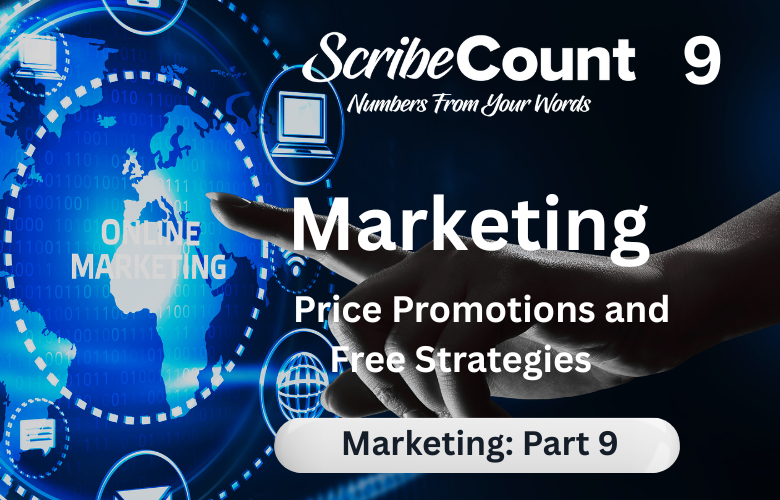Price Promotions and Free Strategies for Indie Authors
In the vast and ever-competitive landscape of indie publishing, price remains one of the most powerful tools at an author’s disposal. Price promotions—ranging from steep discounts to limited-time free offerings—have become central to the marketing strategies of thousands of successful self-published writers. Whether used to launch a new book, revive a backlist title, or build momentum for an entire series, promotions based on price manipulation allow indie authors to control demand, create urgency, and engineer visibility across major retailers and direct storefronts.
Price promotions, when executed with purpose, are not just about short-term spikes in sales. They are strategic campaigns designed to increase visibility, fuel algorithmic discovery, gather new readers, and set the foundation for future revenue. Free books, especially, serve as powerful loss leaders that can lead readers deeper into a series or backlist, ultimately increasing profitability over time.
In this guide, we’ll explore the full scope of pricing strategies available to indie authors. You’ll learn how to structure campaigns using bundles, upselling, urgency, and scarcity, and how to combine them with paid ads and newsletter promos for maximum impact. We’ll cover the pros and cons, requirements, and platform-specific approaches for ebooks, audiobooks, and print editions. Finally, we’ll define and explore ROI (Return on Investment) and ROAS (Return on Ad Spend), two critical metrics every author must understand to evaluate success.
What Are Price Promotions?
Price promotions refer to any temporary change to a book’s retail price for the purpose of increasing sales, visibility, downloads, or engagement. These include full or partial discounts, time-limited deals, exclusive platform campaigns, and free giveaways. Most often used with ebooks, price promotions can also be applied to audiobooks and print when managed correctly.
These promotions are typically used in one of three ways:
- To drive downloads and reader engagement (especially with free or $0.99 books)
- To support a launch, relaunch, or backlist campaign
- To boost the visibility of a series by promoting the first book
When paired with other tactics—such as paid ads, newsletter features, social campaigns, and direct store discounts—price promotions can dramatically increase both short-term sales and long-term read-through.
The Strategic Role of Free Books as Loss Leaders
One of the most effective uses of price promotions is offering the first book in a series for free. Known as a loss leader strategy, this approach sacrifices immediate revenue from Book One in exchange for the higher value of later sales in the series. When executed properly, a free series starter can build a long-term readership, increase review volume, improve email opt-in rates, and boost revenue across all formats.
On Amazon, authors in KDP Select can use Free Book Promotions to make their book free for up to five days per 90-day enrollment period. On wide platforms—such as Kobo, Apple Books, Barnes & Noble, and Google Play—authors can permanently price Book One at $0.00 or run time-based promotions as desired. These free books can then be promoted via services like BookBub, Freebooksy, Fussy Librarian, and Written Word Media.
When using free books as a lead magnet, it's essential to ensure strong links to subsequent books in the series. Authors should include sample chapters, linked reading order, or bonus content to encourage progression. Platforms like Books2Read allow the creation of universal links that guide readers to the next title, regardless of their preferred store.
Authors who sell direct via Shopify, Payhip, or Lemon Squeezy can create their own free download funnels using delivery tools like BookFunnel and automation platforms like Klaviyo. These funnels often collect email addresses in exchange for the free book, making them invaluable for long-term relationship building.
Using Price Drops to Create Scarcity and Urgency
Temporary discounts—from $4.99 down to $0.99 or $1.99—can generate urgency and FOMO (fear of missing out) when positioned as limited-time deals. These are often tied to a launch campaign, seasonal sale, or cross-promotional push and work particularly well when paired with countdown clocks, bold graphics, and time-sensitive calls to action.
On Amazon, Kindle Countdown Deals allow authors enrolled in KDP Select to run multi-day discounts with a visible timer, reinforcing urgency. These deals are eligible for 70% royalties (instead of 35%), even at low price points.
On wide platforms, authors must manually adjust prices and coordinate with aggregators like Draft2Digital or PublishDrive. Platforms like Kobo Writing Life allow for scheduled promos and curated pricing campaigns, often featured in their Promotions Dashboard.
Authors often reinforce urgency by announcing the deal through email marketing, social media countdowns, and newsletter swaps using StoryOrigin. Graphics created via Canva or BookBrush enhance visibility and professionalism.
Bundles, Upselling, and Cross-Promotion
Bundling books—whether as box sets or omnibus editions—lets authors offer high perceived value at a discounted price. Readers who purchase bundles often read more books per session and are more likely to engage with the author’s email list or leave reviews.
Authors frequently bundle the first three books of a series and sell the collection at a price lower than purchasing the titles individually. This works well on Amazon, Apple Books, and Kobo, and is particularly effective when offered during promotions like Kindle Deals or through direct sales storefronts. Authors can also create exclusive bundle discounts for newsletter subscribers or Patreon supporters.
Upselling occurs when readers who enter a funnel via a discounted or free book are presented with a higher-value offer later in the journey—such as a premium hardcover, audiobook, or complete series package. This is especially effective on direct storefronts using Shopify apps or WooCommerce plugins for order bumps and upgrades.
Cross-promotion involves teaming up with other authors in the same genre to run genre-themed bundles or shared discount campaigns. This tactic increases reach and drives mutual discovery. Promo stacking with newsletter swaps, social posts, and featured listings creates a rising-tide effect, benefiting every author in the group.
Applying Price Promotions Across Ebook, Print, and Audio Formats
While ebook promotions are the most common, authors also leverage print and audio formats in their pricing strategy.
For audiobooks, services like Chirp and Authors Direct allow for curated or direct price drops. Authors using Findaway Voices or Spotify for Authors can set limited-time discounts and coordinate them with ads, swaps, or social campaigns.
Print promotions are more complex due to production costs, but authors often run bundled print discounts through their direct sales sites. Offering signed editions or limited-run prints can create scarcity and drive up perceived value—especially for superfans or collectors.
Ebook price promotions remain the fastest-moving, most easily scaled, and lowest-cost format to execute. When combined with higher-value audio or print options, they serve as powerful entry points for long-term customer conversion.
Measuring Success: ROI and ROAS for Price Promotions
To evaluate whether a promotion was successful, authors must understand two key metrics: ROI (Return on Investment) and ROAS (Return on Ad Spend).
ROI is a broad measure of total return compared to total investment. If an author spends $200 on ads, promo listings, and tools—and earns $600 from a promotion—the ROI is 200%. This includes all related costs, from advertising to graphics.
ROAS focuses only on the return from a specific ad campaign. If $50 in Meta Ads generates $250 in attributed sales, the ROAS is 5.0—five dollars earned for every dollar spent.
Tools like ScribeCount allow authors to track daily income across Amazon, Kobo, Apple Books, Barnes & Noble, and other retailers. Paired with dashboards from Facebook Ads Manager or BookBub Ads, authors can get a clear view of which promotions are delivering profit—and which need refinement.
Authors also measure the long-term effects of free books and low-priced loss leaders. If 2,000 readers download Book One and 25% go on to buy the rest of the series, the cumulative revenue from later books justifies the initial cost. Advanced marketers calculate read-through and lifetime customer value (LTV) to estimate ongoing ROI beyond the first campaign.
Pros and Cons of Price Promotions
Price promotions offer indie authors powerful advantages: instant visibility, algorithmic boost, platform discovery, and the ability to attract new readers without relying solely on paid advertising. Free books can supercharge newsletter growth, discount campaigns can spike rankings, and limited-time sales create urgency that turns browsing into buying.
However, there are drawbacks. Frequent discounts can train readers to expect lower prices, reducing perceived value. Free promos without follow-through may fail to convert. And poorly timed sales can waste money if not coordinated with ads or mailing list support. Platform policies, like KDP Select exclusivity, may also limit promotional flexibility.
Authors who succeed with price promotions plan them carefully, use them strategically, and combine them with broader campaigns for sustained impact.
Combining Price Promotions with Paid Advertising
The most effective price promotions are never standalone events. They are coordinated with other marketing tools—especially paid advertising.
For example, an author running a $0.99 sale might:
- Book a BookBub Ad targeting fans of similar authors
- Layer in a Freebooksy or Bargain Booksy promotion
- Run Meta Ads to retarget website visitors
- Swap newsletters with authors using StoryOrigin or BookFunnel
- Promote through their own email list, enhanced by automation through Klaviyo or MailerLite
This layering strategy increases visibility across channels and audience segments. The price drop attracts new readers, the ads reinforce awareness, and the email list conversion begins a long-term relationship. Promotions become not just sales spikes, but customer acquisition engines.
Final Thoughts: Price with Purpose
Price promotions, when used intentionally, are more than just discounts. They are discovery tools, list-building strategies, and career multipliers. They help indie authors cut through the noise, drive visibility, and introduce new readers to stories they might otherwise never find.
Whether offering the first book in a series for free, stacking a week of coordinated $0.99 campaigns, or bundling formats for an exclusive direct sale, price is a lever indie authors can pull strategically—and repeatedly—for strong returns.
But success comes not from dropping the price alone. It comes from understanding your audience, combining tools effectively, measuring your outcomes, and refining your approach over time. With the right platforms, tracking systems, and creative execution, indie authors can turn every price promotion into a step forward on the path to a sustainable and scalable publishing career.

